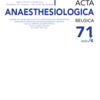Anesthetic neurotoxicity in the pediatric population: a systematic review of the clinical evidence
Anesthesia ; toxicity ; pediatrics ; growth and development
Published online: Jun 30 2020
Abstract
Background: Exposure to general anesthesia (GA) in early life is known to be neurotoxic to animals.
Objectives: To evaluate the risk of GA inducing long-term neurodevelopmental deficits in human children.
Design: Systematic review.
Methods: We included observational and randomized studies that compared the long-term neurodevelopment of postnatal children exposed to GA to the long-term neurodevelopment of children not exposed to GA. We searched MEDLINE, Embase and Web of Science for relevant studies published in the year 2000 or later. We screened all the identified studies on predetermined inclusion and exclusion criteria. A risk of bias assessment was made for each included study. We identified 9 neurodevelopmental domains for which a sub-analysis was made: intelligence; memory; learning; language/speech; motor function; visuospatial skills; development/emotions/behavior; ADHD/attention; autistic disorder.
Results: We included 26 studies involving 605.391 participants. Based on AHRQ-standards 11 studies were of poor quality, 7 studies were of fair quality and 8 studies were of good quality. The major causes of potential bias were selection and comparability bias. On 2 neurodevelopmental domains (visuospatial skills and autistic disorder), the available evidence showed no association with exposure to GA. On 7 other neurodevelopmental domains, the available evidence showed mixed results. The 4 studies that used a randomized or sibling-controlled design showed no association between GA and neurodevelopmental deficits in their primary endpoints.
Limitations: The absence of a meta-analysis and funnel plot.
Conclusions: Based on observational studies, we found an association between GA in childhood and neuro-developmental deficits in later life. Randomized and sibling-matched observational studies failed to show the same association and therefore no evidence of a causal relationship exists at present. Since GA seems to be a marker, but not a cause of worse neurodevelopment, we argue against delaying or avoiding interventional or diagnostic procedures requiring GA in childhood based on the argument of GA-induced neurotoxicity.
